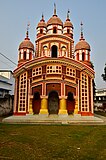The temple
David J. McCutchion says that the lower structure of the pinnacled or ratna design is a rectangular box with a curved cornice. The roof follows the curvature of the cornice, and “is surmounted by one or more towers or pinnacles called ratna (jewel). The simplest form has a single central tower (eka-ratna), to which may be added four more at the corners (pancha-ratna)”. By increasing the towers or pinnacles to nine (nava-ratna), thirteen, seventeen and twentyone up to a maximum of twentyfive. The ratna style came up in the 15th-16th century. The earliest nava-ratna temples in Midnapore were probably in the Sabang area in the early 18th century. McCutchion classifies the Shantinatha Shiva temple as a West Bengal nava-ratna with ridged turrets. He mentions that at Chandrakona (both at Dakhinbazar and Mitrasenpur), the four lowest turrets are octagonal with curved ridging and the upper five pancha-ratna with straight ridging. Built in 1828, it has rich terracotta and measures 19’ 6” square. [1]
The Shantinatha Shiva temple, with nine pinnacles, has exquisite terracotta which showcases the Ramayana battles, several scenes from Krishna lila, Bhisma on a bed of arrows, Dasavtar of Vishnu, several musicians etc. Local authorities have renovated the temple using many colours. However, the details of the terracotta relief are still there. [2]
The Shantinatha Shiva temple is a state protected monument. [3]
See also - Other temples at Chandrakona: Chandrakona Jorbangla Temple, Malleswara Shiva Temple, Parvatinatha Temple
This page is based on this
Wikipedia article Text is available under the
CC BY-SA 4.0 license; additional terms may apply.
Images, videos and audio are available under their respective licenses.









